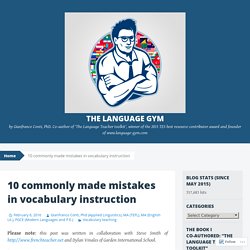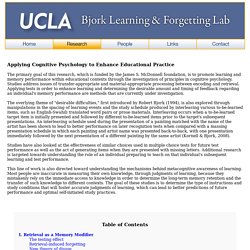

10 commonly made mistakes in vocabulary instruction. Please note: this post was written in collaboration with Steve Smith of and Dylan Vinales of Garden International School.

In this post I will concern myself with ten very common pitfalls of vocabulary instruction and with ways in which they can be easily pre-empted. Mistake1 – Shallow encoding practices As already mentioned in many previous posts of mine, a to-be-learnt word lingers in our Working Memory for no longer than two or three seconds immediately after we hear it. Thus, in order to commit it effectively to Long-term Memory, we must perform some form of rehearsal. Rehearsal involves either ‘shallow’ or ‘deep’ processing. In shallow processing we use repetition or matching a word to a visual cue. Example: if you taught your students ten words using some of the www.linguascope.com very entertaining games (e.g. matching words to pictures; word dictation; spelling games), they will have performed lots of fun activities for 10-15 minutes.
Mistake 2 – Limited contextualized practice. Bjork Learning and Forgetting Lab - Research. Applying Cognitive Psychology to Enhance Educational Practice The primary goal of this research, which is funded by the James S.

McDonnell foundation, is to promote learning and memory performance within educational contexts through the investigation of principles in cognitive psychology. Studies address issues of transfer-appropriate and material-appropriate processing between encoding and retrieval. Applying tests in order to enhance learning and determining the desirable amount and timing of feedback regarding an individual's memory performance are methods that are currently under investigation. The overlying theme of "desirable difficulties," first introduced by Robert Bjork (1994), is also explored through manipulations in the spacing of learning events and the study schedule produced by interleaving various to-be-learned items, such as English-Swahili translated word pairs or prose materials.
I. In recent years, we have explored this phenomenon in a variety of ways. II. When 1 + 1 = 5: Dyscalculia and Working Memory. Jacob's mother writes that ‘Jacob, 10-years-old, still struggles with number bonds to 10. Learning to tell the time is still slow - he has not mastered half-past. Although he managed to learn his 5x tables because we practiced all summer, this has now gone'. Jacob has dyscalculia, a math disability where students struggle to learn or understand mathematics. Students with dyscalculia find it difficult to decipher math symbols (e.g. +, -), counting principles (‘two' stands for 2), solving arithmetic problems, and usually transpose numbers (e.g. 75 becomes 57). However, dyscalculia encompasses more than problems with numbers - there is also a struggle with telling the time as in Jacob's case, identifying left from right, and recognizing patterns.
But why do some students struggle to learn numbers and certain mathematical principles? Working Memory plays a key role. Like Jacob, the student with dyscalculia has clear working memory deficits. Reference Alloway, T.P. & Passolunghi, MC. (2011). Improving Working Memory: Supporting Students' Learning: Tracy Packiam Alloway: 9781849207485. Jungle Memory. Working Memory and the Classroom. PATOSS. Classroom guide.pdf. Working memory. Working memory is the system that actively holds multiple pieces of transitory information in the mind, where they can be manipulated.

Working memory is generally used synonymously with short term memory, but this depends on how the two forms of memory are defined.[1] Working memory includes subsystems that store and manipulate visual images or verbal information, as well as a central executive that coordinates the subsystems. It includes visual representation of the possible moves, and awareness of the flow of information into and out of memory, all stored for a limited amount of time.[2] Working memory tasks require monitoring (i.e., manipulation of information or behaviors) as part of completing goal-directed actions in the setting of interfering processes and distractions. The cognitive processes needed to achieve this include the executive and attention control of short-term memory, which permit interim integration, processing, disposal, and retrieval of information.
History[edit] Working Memory and Learning: A Practical Guide for Teachers: Susan Gathercole: 9781412936132.